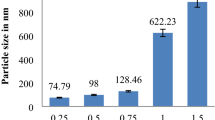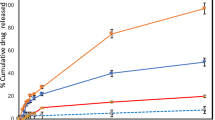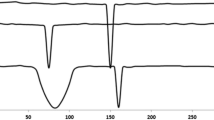Abstract
Polyphenols such as curcumin (Cur) and resveratrol (Res) have been recently shown to have potential to inhibit proliferation of highly aggressive melanoma cells. This study was designed to investigate the feasibility of a topical delivery system, using a solid lipid nanoparticles (SLNs) loaded delivery systems, that can enhance the skin penetration and anti-cancer efficacy of combination of these polyphenols. Negatively charged Cur-Res SLNs with a mean diameter of 180.2 ± 7.7 nm were prepared using high shear homogenization method. Cur-Res SLNs were found to be stable up to 2 weeks under 4°C. The in vitro release study showed that Res was released five time more than curcumin. The permeability of resveratrol was about 1.67 times that of curcumin from the SLN-gel formulation which was significantly (p < 0.05) lower than from SLN suspension. More than 70% of Cur-Res SLNs were bound to skin locally in a skin binding study suggesting potentially utility of Cur-Res SLNs in the treatment of localized melanoma. In fact, the electrical cell-substrate impedance sensing (ECIS) measurements suggested that Cur-Res combination has potential to stop cell migration of B16F10 melanoma cells. Furthermore, both, Cur-Res SLNs and Cur-Res solution at the ratio of 3:1 demonstrated a strong synergistic inhibition of SK-MEL-28 melanoma cell proliferation. Further evaluation of Cur-Res SLNs in vivo melanoma models are warranted to establish the clinical utility of Cur-Res formulations in melanoma therapy.
Graphical abstract












Similar content being viewed by others
References
Aburahma M, Badr-Eldin S. Compritol 888 ATO: a multifunctional lipid excipient in drug delivery systems and nanopharmaceuticals. Expert Opinion on Drug Delivery. 2014;11(12):1865–83.
Akhtar N. Vesicles: a recently developed novel carrier for enhanced topical drug delivery. Current Drug Delivery. 2014;11(1):87–97.
Albash R, Abdelbary AA, Refai H, El-Nabarawi MA. Use of transethosomes for enhancing the transdermal delivery of olmesartan medoxomil: in vitro, ex vivo, and in vivo evaluation. Int J Nanomedicine. 2019;14:1953–68. https://doi.org/10.2147/IJN.S196771.
American cancer society. (2019). Key statistics for melanoma skin cancer. Retrieved 03/10, 2018, from https://www.cancer.org/cancer/melanoma-skin-cancer/about/key-statistics.html.
Ansari K, Vavia P, Trotta F, Cavalli R. Cyclodextrin-based nanosponges for delivery of resveratrol: In vitro characterisation, stability, cytotoxicity and permeation study. AAPS PharmSciTech. 2011;12(1):279–86.
Anuchapreeda S, Fukumori Y, Okonogi S, Ichikawa H. Preparation of lipid nanoemulsions incorporating curcumin for cancer therapy. Journal of Nanotechnology. 2012;2012:1–11.
Bhardwaj A, Sethi G, Vadhan-Raj S, Bueso-Ramos C, Takada Y, Gaur U, et al. Resveratrol inhibits proliferation, induces apoptosis, and overcomes chemoresistance through down-regulation of STAT3 and nuclear factor regulated antiapoptotic and cell survival gene products in human multiple myeloma cells. Blood. 2007;109(6):2293–302.
Bhatia, S., Tykodi, S. S., & Thompson, J. A. (2009). Treatment of metastatic melanoma: An overview. Oncology (Williston Park, N.Y.), 23(6), 488–496.
Bhatt P, Lalani R, Vhora I, Patil S, Amrutiya J, Misra A, et al. Liposomes encapsulating native and cyclodextrin enclosed paclitaxel: enhanced loading efficiency and its pharmacokinetic evaluation. Int J Pharm. 2018;536(1):95–107. https://doi.org/10.1016/j.ijpharm.2017.11.048.
Brubach JB, Jannin V, Mahler B, Bourgaux C, Lessieur P, Roy P, et al. Structural and thermal characterization of glyceryl behenate by X-ray diffraction coupled to differential calorimetry and infrared spectroscopy. Int J Pharm. 2007;336(2):248–56.
Carletto, B., Berton, J., Ferreira, T. N., Dalmolin, L. F., Paludo, K. S., Mainardes, R. M., et al. (2016). Resveratrol-loaded nanocapsules inhibit murine melanoma tumor growth doi:https://doi.org/10.1016/j.colsurfb.2016.04.001.
Chen J, Li L, Su J, Li B, Chen T, Wong Y. Synergistic apoptosis-inducing effects on A375 human melanoma cells of natural borneol and curcumin. PLoS One. 2014;9(6):e101277.
Chen Y, Wu Q, Zhang Z, Yuan L, Liu X, Zhou L. Preparation of curcumin-loaded liposomes and evaluation of their skin permeation and pharmacodynamics. Molecules (Basel, Switzerland). 2012;17(5):5972–87.
Chou, T. (2006). In Chou T. (Ed.), Theoretical basis, experimental design, and computerized simulation of synergism and antagonism in drug combination studies.
Coradini K, Lima FO, Oliveira CM, Chaves PS, Athayde ML, Carvalho LM, et al. Co-encapsulation of resveratrol and curcumin in lipid-core nanocapsules improves their in vitro antioxidant effects. Eur J Pharm Biopharm. 2014;88(1):178–85.
Danaei M, Dehghankhold M, Ataei S, Hasanzadeh Davarani F, Javanmard R, Dokhani A, et al. Impact of particle size and Polydispersity index on the clinical applications of Lipidic Nanocarrier systems. Pharmaceutics. 2018;10(2):57. https://doi.org/10.3390/pharmaceutics10020057.
Das RK, Kasoju N, Bora U. Encapsulation of curcumin in alginate-chitosan-pluronic composite nanoparticles for delivery to cancer cells. Nanomedicine. 2010;6(1):153–60.
Desai, P., Patlolla, R. R., & Singh, M. (2010). Interaction of nanoparticles and cell-penetrating peptides with skin for transdermal drug delivery. Molecular membrane biology, 2010, 27; Vol.27(7; 7), 247; 247-259; 259.
Deshpande, A. A. (2015). Formulation, characterization and evaluation of paclitaxel loaded solid lipid nanoparticles prepared by temperature modulated solidification technique. (Master of Science, The University of Toledo).
Du Q, Hu B, An H, Shen K, Xu L, Deng, S. And Wei, M. Synergistic anticancer effects of curcumin and resveratrol in Hepa1-6 hepatocellular carcinoma cells. Oncol Rep. 2013;29(5):1851–8.
Ediriwickrema A, Zhou J, Deng Y, Saltzman W. Multi-layered nanoparticles for combination gene and drug delivery to tumors. Biomaterials. 2014;35(34):9343–54.
El-Housiny S, Shams Eldeen MA, El-Attar Y, Salem HA, Attia D, Bendas ER, et al. Fluconazole-loaded solid lipid nanoparticles topical gel for treatment of pityriasis versicolor: formulation and clinical study. Drug Delivery. 2018;25(1):78–90.
Freitas C, Müller RH. Effect of light and temperature on zeta potential and physical stability in solid lipid nanoparticle (SLN™) dispersions. Int J Pharm. 1998;168(2):221–9.
Freitas C, Müller RH. Correlation between long-term stability of solid lipid nanoparticles (SLN™) and crystallinity of the lipid phase. Eur J Pharm Biopharm. 1999;47(2):125–32. https://doi.org/10.1016/S0939-6411(98)00074-5.
Friedrich, R. B., Kann, B., Coradini, K., Offerhaus, H. L., Beck, R. C. R., & Windbergs, M. (2015). Skin penetration behavior of lipid-core nanocapsules for simultaneous delivery of resveratrol and curcumin. European journal of pharmaceutical sciences, 78, 204-213. 117.
Fuggetta P, Maria D’a P, Stefania L, Giulia P, Tricarico PM, Cannavò P, et al. In vitro antitumour activity of resveratrol in human melanoma cells sensitive or resistant to temozolomide. Melanoma Res. 2004a;14(3):189–96.
Giaever I, Keese C. Monitoring fibroblast behavior in tissue culture with an applied electric field. Proc Natl Acad Sci. 1984;81(12):3761–4.
Gokce, E., Korkmaz, E., Dellera, E., Sandri, G., Bonferoni, C. and Ozer, O. (2019). Resveratrol-loaded solid lipid nanoparticles versus nanostructured lipid carriers: evaluation of antioxidant potential for dermal applications, 7, 1841–1850.
Gui F, Ma W, Cai S, Li X, Tan Y, Zhou C, et al. Preliminary study on molecular mechanism of curcumine anti-mouse melanoma. Pubmed. 2008;31(11):1685–9.
Gupta, S., Kesarla, R., Chotai, N., Misra, A., & Omri, A. (2017). Systematic approach for the formulation and optimization of solid lipid nanoparticles of efavirenz by high pressure homogenization using design of experiments for brain targeting and enhanced bioavailability. BioMed Research international, 2017.
Heenatigala Palliyage G, Singh S, Ashby C, Tiwari A, Chauhan H. Pharmaceutical topical delivery of poorly soluble polyphenols: potential role in prevention and treatment of melanoma. AAPS PharmSciTech. 2019;20(6):1–24.
Heijink IH, Brandenburg SM, Noordhoek JA, Postma DS, Slebos D, van Oosterhout AJM. Characterisation of cell adhesion in airway epithelial cell types using electric cell-substrate impedance sensing. Eur Respir J. 2010;35(4):894–903.
Heurtault B, Saulnier P, Pech B, Proust JE, Benoit JP. Physico-chemical stability of colloidal lipid particles. Biomaterials. 2003;24:4283–300.
Hu C, Wang Q, Ma C, Xia Q. Non-aqueous self-double-emulsifying drug delivery system: a new approach to enhance resveratrol solubility for effective transdermal delivery. Colloids Surf A Physicochem Eng Asp. 2016;489:360–9.
Hu L, Xing Q, Meng J, Shang C. Preparation and enhanced oral bioavailability of cryptotanshinone-loaded solid lipid nanoparticles. AAPS PharmSciTech. 2010;11(2):582–7.
Itoh T, Xia J, Magavi R, Nishihata T, Rytting JH. Use of shed snake skin as a model membrane for in vitro percutaneous penetration studies: comparison with human skin. Pharm Res. 1990;7:1042–7.
Jayaprakasha GK, Chidambara Murthy KN, Patil BS. Enhanced colon cancer chemoprevention of curcumin by nanoencapsulation with whey protein. Eur J Pharmacol. 2016;789:291–300.
Jiang H, Shang X, Wu H, Gautam SC, Al-Holou S, Li C, et al. Resveratrol downregulates PI3K/Akt/mTOR signaling pathways in human U251 glioma cells. Journal of Experimental Therapeutics & Oncology. 2009;8(1):25–33.
Jiang, W. G. (2012). Electric cell-substrate impedance sensing and cancer metastasis (1st ed. 2012. Ed.) Dordrecht: springer Netherlands: imprint: springer.
Johnston ST, Shah ET, Chopin LK, Sean McElwain DL, Simpson MJ. Estimating cell diffusivity and cell proliferation rate by interpreting IncuCyte ZOOMTM assay data using the fisher-kolmogorov model. BMC Syst Biol. 2015;9(1):38.
Kleijn, A., Kloezeman, J. J., Balvers, R. K., Kaaij, M., Dirven, C. M. F., Leenstra, S., et al. (2016). A systematic comparison identifies an ATP-based viability assay as most suitable read-out for drug screening in glioma stem-like cells. Stem Cells International, 2016.
Klein MC, Gorb SN. (2012) Epidermis architecture and material properties of the skin of four snake species. J R Soc Interface. 2012 Nov 7;9(76):3140–55. doi: 10.1098/rsif.2012.0479. Epub 2012 Aug 15. PMID: 22896567; PMCID: PMC3479930.
Kumpugdee-Vollrath, M., Subongkot, T., & Ngawhirunpat, T. (2013). Model membrane from shed Snake skins, International Journal of Pharmacological and Pharmaceutical Science, 7(10).
Lee J, Jang J, Park C, Kim B, Choi Y, Choi B. Curcumin suppresses α-melanocyte stimulating hormone-stimulated melanogenesis in B16F10 cells. Int J Mol Med. 2010;26(1):101–6.
Lei M, Dong Y, Sun C, Zhang X. Resveratrol inhibits proliferation, promotes differentiation and melanogenesis in HT-144 melanoma cells through inhibition of MEK/ERK kinase pathway. Microb Pathog. 2017;111:410–3. https://doi.org/10.1016/j.micpath.2017.09.029.
Lo C, Keese CR, Giaever I. Monitoring motion of confluent cells in tissue culture. Exp Cell Res. 1993;204(1):102–9. https://doi.org/10.1006/excr.1993.1014.
Loch-Neckel G, Santos-Bubniak L, Mazzarino L, Jacques AV, Moccelin B, Santos-Silva M, et al. Orally administered chitosan-coated polycaprolactone nanoparticles containing curcumin attenuate metastatic melanoma in the lungs. J Pharm Sci. 2015;104(10):3524–34.
Lundien M, Mohammed K, Nasreen N, Tepper R, Hardwick J, Sanders K, et al. Induction of MCP-1 expression in airway epithelial cells: role of CCR2 receptor in airway epithelial injury. J Clin Immunol. 2002;22(3):144–52.
Majumdar APN, Banerjee S, Nautiyal J, Patel BB, Patel V, Du J, et al. Curcumin synergizes with resveratrol to inhibit colon cancer. Nutr Cancer. 2009;61(4):544–53.
Mazzarino L, Otsuka I, Halila S, Bubniak LDS, Mazzucco S, Santos-Silva MC, et al. Xyloglucan- block -poly(ϵ-Caprolactone) copolymer nanoparticles coated with chitosan as biocompatible mucoadhesive drug delivery system. Macromol Biosci. 2014;14(5):709–19.
Naik B, Gandhi J, Shah P, Naik H, Sarolia J. Asenapine maleate loaded solid lipid nanoparticles for oral delivery. International Research Journal Of Pharmacy. 2017;8(11):45–53. https://doi.org/10.7897/2230-8407.0811216.
Naves LB, Dhand C, Venugopal JR, Rajamani L, Ramakrishna S, Almeida L. Nanotechnology for the treatment of melanoma skin cancer. Progress in Biomaterials. 2017;6(1):13–26.
Oliveira CP, Venturini CG, Donida B, Poletto FS, Guterres IS, Pohlmann AR. An algorithm to determine the mechanism of drug distribution in lipid-corenanocapsule formulations. Soft Matter. 2013;9:1141–50.
Opp, Daniel, "ECIS assessment of cytotoxicity and trans-endothelial migration of metastatic cancer cells" (2009). Graduate Theses and Dissertations. http://scholarcommons.usf.edu/etd/2125
Pando D, Caddeo C, Manconi M, Fadda AM, Pazos C. Nanodesign of olein vesicles for the topical delivery of the antioxidant resveratrol. J Pharm Pharmacol. 2013;65(8):1158–67.
Pardeshi C, Rajput P, Belgamwar V, Tekade A, Patil G, Chaudhary K, et al. Solid lipid based nanocarriers: An overview / nanonosaci na bazi cvrstih lipida: Pregled. Acta Pharma. 2012;62(4):433–72.
Patel, Meghavi (2012) "Development, characterization and evaluation of solid lipid nanoparticles as a potential anticancer drug delivery system" Theses and Dissertations 400.
Pongjanyakul T, Prakongpan S, Priprem A. Permeation studies comparing cobra skin with human skin using nicotine transdermal patches. Drug Dev Ind Pharm. 2000;26(6):635–42.
Pushpalatha R, Selvamuthukumar S, Kilimozhi D. Comparative Insilico docking analysis of Curcumin and resveratrol on breast Cancer proteins and their synergistic effect on MCF-7 cell line. Journal of Young Pharmacists. 2017;9(4):480–5.
Pushpalatha R, Selvamuthukumar S, Kilimozhi D. Cyclodextrin nanosponge based hydrogel for the transdermal co-delivery of curcumin and resveratrol: development, optimization, in vitro and ex vivo evaluation. Journal of Drug Delivery Science and Technology. 2019;52:55–64.
Ray P, Yu H, Fu P. Toxicity and environmental risks of Nanomaterials: challenges and future needs. Journal of Environmental Science and Health, Part C. 2009;27(1):1–35.
Sahebkar A. Dual effect of curcumin in preventing atherosclerosis: the potential role of pro-oxidant–antioxidant mechanisms. Nat Prod Res. 2014;29(6):491–2.
Sambale F, Wagner S, Stahl F, Khaydarov R, Scheper T, Bahnemann D. Investigations of the toxic effect of silver nanoparticles on mammalian cell lines. J Nanomater. 2015;2015:1–9. https://doi.org/10.1155/2015/136765.
Saralkar P, Dash A. Alginate nanoparticles containing Curcumin and resveratrol: preparation, characterization, and in vitro evaluation against DU145 prostate Cancer cell line. AAPS PharmSciTech. 2017;18(7):2814–23. https://doi.org/10.1208/s12249-017-0772-7.
Schaefer H, Zesch A, Stuttgen G. Penetration, permeation, and absorption of triamcinolone acetonide in Normal and psoriatic skin. Archives for Dermatological Research. 1977;258(3):241–9.
Sengupta S, Banerjee S, Sinha B, Mukherjee B. Improved Skin Penetration Using In Situ Nanoparticulate Diclofenac Diethylamine in Hydrogel Systems: In Vitro and In Vivo Studies. AAPS PharmSciTech. 2016;17:307–17. https://doi.org/10.1208/s12249-015-0347-4.
Shah, R. (2016). Microwave-assisted production of solid lipid nanoparticles. (Doctodoctoral dissertations, Swinburne University of Technology).
Shelat P, Mandowara V, Gupta D, Patel S. Formulation of curcuminoid loaded solid lipid nanoparticles in order to improve oral bioavailability. Int J Pharm Pharm Sci. 2018;7(6).
Shenfield GM. Fixed combination drug therapy. Drugs. 1982;23(6):462–80.
Siepmann, J., & Siepmann, F. (2011). Mathematical modeling of drug release from lipid dosage forms doi:https://doi.org/10.1016/j.ijpharm.2011.07.015.
Single A, Beetham H, Telford BJ, Guilford P, Chen A. A comparison of real-time and endpoint cell viability assays for improved synthetic lethal drug validation. J Biomol Screen. 2015;20(10):1286–93.
Siwak DR, Shishodia S, Aggarwal BB, Kurzrock R. Curcumin-induced antiproliferative and proapoptotic effects in melanoma cells are associated with suppression of IκB kinase and nuclear factor κB activity and are independent of the B-Raf/mitogen-activated/extracellular signal-regulated protein kinase pathway and the akt pathway. Cancer. 2005;104(4):879–90.
Souto EB, Mehnert W, Müller RH. Polymorphic behaviour of Compritol®888 ATO as bulk lipid and as SLN and NLC. J Microencapsul. 2006;23(4):417–33.
Sugimoto T. Chapter 4 - recrystallization. Monodispersed Particles. 2001:139–54. https://doi.org/10.1016/B978-044489569-1/50022-1.
Sun C, Wu MH, Guo M, Day ML, Lee ES, Yuan SY. ADAM15 regulates endothelial permeability and neutrophil migration via Src/ERK1/2 signalling. Cardiovasc Res. 2010;87(2):348–55.
Sun, Y., Du, L., Liu, Y., Li, X., Li, M., Jin, Y., et al.(2014). Transdermal delivery of the in-situ hydrogels of curcumin and its inclusion complexes of hydroxypropyl-β-cyclodextrin for melanoma treatment doi:https://doi-org.cuhsl.creighton.edu/10.1016/j.ijpharm.2014.04.039.
Szulcek, R., Bogaard, H. J., & van Nieuw Amerongen, G.,P. (2014a). Electric cell-substrate impedance sensing for the quantification of endothelial proliferation, barrier function, and motility. Journal of Visualized Experiments: JoVE, (85).
Szulcek, R., Bogaard, H. J., & van Nieuw Amerongen, G.,P. (2014b). Electric cell-substrate impedance sensing for the quantification of endothelial proliferation, barrier function, and motility. Journal of Visualized Experiments: JoVE, (85).
Tang J, Ji H, Ren J, Li M, Zheng N, Wu L. Solid lipid nanoparticles with TPGS and Brij 78: a co-delivery vehicle of curcumin and piperine for reversing P-glycoprotein-mediated multidrug resistance in vitro. Oncol Lett. 2017;13(1):389–95. https://doi.org/10.3892/ol.2016.5421.
Uner M. Preparation, characterization and physico-chemical properties of solid lipid nanoparticles (SLN) and nanostructured lipid carriers (NLC): their benefits as colloidal drug carrier systems. Pharmazie. 2006;61(5):375–86.
Wang B, Liu X, Teng Y, Yu T, Chen J, Hu Y, et al. Improving anti-melanoma effect of curcumin by biodegradable nanoparticles. Oncotarget. 2017a;8(65):108624–42.
Wang B, Liu X, Teng Y, Yu T, Chen J, Hu Y, et al. Improving anti-melanoma effect of curcumin by biodegradable nanoparticles. Oncotarget. 2017b;8(65):108624–42.
Wang M, Yu T, Zhu C, Sun H, Qiu Y, Zhu X, et al. Resveratrol triggers protective autophagy through the Ceramide/Akt/mTOR pathway in melanoma B16 cells. Nutrition & Cancer. 2014;66(3):435–40.
Wichitnithad W, Nimmannit U, Callery PS, Rojsitthisak P. Effects of different carboxylic ester spacers on chemical stability, release characteristics, and anticancer activity of mono-PEGylated curcumin conjugates. J Pharm Sci. 2011;100(12):5206–18.
Wu Z, Liu BEC, Liu J, Zhang Q, Liu J, Chen N, et al. Resveratrol inhibits the proliferation of human melanoma cells by inducing G1/S cell cycle arrest and apoptosis. Mol Med Rep. 2014;11(1):400–4.
Ying X, Cui D, Yu L, Du Y. Solid lipid nanoparticles modified with chitosan oligosaccharides for the controlled release of doxorubicin. Carbohydr Polym. 2011;84(4):1357–64.
Zang Y, Hao D, Wang H, Yang Z, Liu H, Zhang S. Structure-based methoxyflavone derivatives with potent inhibitory activity against various influenza neuraminidases. J Biomol Struct Dyn. 2019;15:1–10. https://doi.org/10.1080/07391102.2019.1680436.
Author information
Authors and Affiliations
Corresponding author
Additional information
Guest Editor: Sheng Qi
Publisher’s Note
Springer Nature remains neutral with regard to jurisdictional claims in published maps and institutional affiliations.
Supplementary Information
Supplemental Figure 1
The qualitative analysis of samples by ESI MS in Q1 negative mode (PNG 1007 kb) (PNG 1007 kb)
Supplemental Figure 2
UV Spectrum of curcumin and resveratrol in Ethanol. Curcumin showed its maximum absorbance at a wavelength of 424 nm, and that for resveratrol was 306 nm (PNG 164 kb) (PNG 164 kb)
Acknowledgments and Disclosures
The author wishes to acknowledge Creighton University, Omaha, for funding and the use of instruments in completing this project. Dr. Tiwari’s start-up funds (F110760), University of Toledo were used for cell culture studies.
Rights and permissions
About this article
Cite this article
Palliyage, G.H., Hussein, N., Mimlitz, M. et al. Novel Curcumin-Resveratrol Solid Nanoparticles Synergistically Inhibit Proliferation of Melanoma Cells. Pharm Res 38, 851–871 (2021). https://doi.org/10.1007/s11095-021-03043-7
Received:
Accepted:
Published:
Issue Date:
DOI: https://doi.org/10.1007/s11095-021-03043-7




